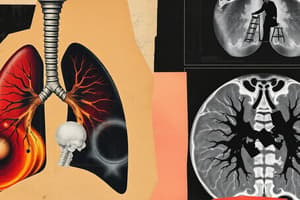Podcast
Questions and Answers
What is the primary purpose of a VQ lung scan?
What is the primary purpose of a VQ lung scan?
- To measure blood pressure
- To assess heart size
- To examine cholesterol levels
- To diagnose suspected pulmonary embolism (correct)
Particles larger than red blood cells can be injected into a peripheral vein for imaging.
Particles larger than red blood cells can be injected into a peripheral vein for imaging.
True (A)
What components make up the VQ lung scan?
What components make up the VQ lung scan?
Ventilation (V) and perfusion (Q)
The particles used in perfusion imaging are called ___ albumin.
The particles used in perfusion imaging are called ___ albumin.
What can the VQ scan be used for besides diagnosing pulmonary embolism?
What can the VQ scan be used for besides diagnosing pulmonary embolism?
The VQ scan does not provide information about pulmonary blood flow.
The VQ scan does not provide information about pulmonary blood flow.
What does Tc-99m stand for in the context of VQ scans?
What does Tc-99m stand for in the context of VQ scans?
After passing through the heart and central pulmonary arteries, the particles lodge in the ___ lung capillaries.
After passing through the heart and central pulmonary arteries, the particles lodge in the ___ lung capillaries.
What does the V in VQ stand for?
What does the V in VQ stand for?
What scoring system is used for pretest determination of PE probability?
What scoring system is used for pretest determination of PE probability?
Pregnancy is included in the Modified Wells Score.
Pregnancy is included in the Modified Wells Score.
What is the total score range for moderate risk in the Modified Wells Scoring System?
What is the total score range for moderate risk in the Modified Wells Scoring System?
A clinical sign of DVT is worth ___ points in the Modified Wells Score.
A clinical sign of DVT is worth ___ points in the Modified Wells Score.
Match the criteria with their corresponding points in the Modified Wells Scoring System:
Match the criteria with their corresponding points in the Modified Wells Scoring System:
What is the percentage risk of PE for patients with a high score (>6) in the Modified Wells Scoring System?
What is the percentage risk of PE for patients with a high score (>6) in the Modified Wells Scoring System?
Pulmonary angiography is frequently performed today for diagnosing PE due to its low invasiveness.
Pulmonary angiography is frequently performed today for diagnosing PE due to its low invasiveness.
What is the minimum score needed to be considered at low risk for PE according to the Modified Wells Scoring System?
What is the minimum score needed to be considered at low risk for PE according to the Modified Wells Scoring System?
A heart rate greater than ___ beats per minute is worth 1.5 points in the Modified Wells Score.
A heart rate greater than ___ beats per minute is worth 1.5 points in the Modified Wells Score.
Which of the following is NOT a criterion in the Modified Wells Scoring System?
Which of the following is NOT a criterion in the Modified Wells Scoring System?
Which factors increase the risk of developing a pulmonary embolus (PE)?
Which factors increase the risk of developing a pulmonary embolus (PE)?
Chest radiographs are typically the most reliable diagnostic tool for pulmonary embolism.
Chest radiographs are typically the most reliable diagnostic tool for pulmonary embolism.
What is the relationship between deep vein thrombosis (DVT) and pulmonary embolism (PE)?
What is the relationship between deep vein thrombosis (DVT) and pulmonary embolism (PE)?
Serum D-dimer is considered _______ but _______.
Serum D-dimer is considered _______ but _______.
Match the diagnostic tests for pulmonary embolism with their characteristics:
Match the diagnostic tests for pulmonary embolism with their characteristics:
What is the primary reason for the difficulty in diagnosing a pulmonary embolus?
What is the primary reason for the difficulty in diagnosing a pulmonary embolus?
Pregnancy is considered to be a moderate risk factor for developing a pulmonary embolism.
Pregnancy is considered to be a moderate risk factor for developing a pulmonary embolism.
What is the mortality rate for untreated pulmonary embolism?
What is the mortality rate for untreated pulmonary embolism?
The likelihood of a positive test result for PE is influenced by ________ probabilities.
The likelihood of a positive test result for PE is influenced by ________ probabilities.
Which of the following statements about PE treatment regimens is true?
Which of the following statements about PE treatment regimens is true?
Flashcards
Pulmonary Embolism (PE)
Pulmonary Embolism (PE)
A condition where a blood clot travels to the lungs, blocking blood flow.
Sensitivity (Test)
Sensitivity (Test)
The ability of a test to correctly identify a condition when it is present.
Specificity (Test)
Specificity (Test)
The ability of a test to correctly identify the absence of a condition.
Pretest Probability
Pretest Probability
Signup and view all the flashcards
Bayes' Theorem
Bayes' Theorem
Signup and view all the flashcards
D-dimer Test
D-dimer Test
Signup and view all the flashcards
Doppler Ultrasound
Doppler Ultrasound
Signup and view all the flashcards
Deep Vein Thrombosis (DVT)
Deep Vein Thrombosis (DVT)
Signup and view all the flashcards
Ventilation/Perfusion (V/Q) Scan
Ventilation/Perfusion (V/Q) Scan
Signup and view all the flashcards
Thrombolysis
Thrombolysis
Signup and view all the flashcards
VQ Lung Scan
VQ Lung Scan
Signup and view all the flashcards
Radiolabeled Particles for Perfusion Imaging
Radiolabeled Particles for Perfusion Imaging
Signup and view all the flashcards
Radiolabeled Gas or Aerosol for Ventilation Imaging
Radiolabeled Gas or Aerosol for Ventilation Imaging
Signup and view all the flashcards
Ventilation
Ventilation
Signup and view all the flashcards
Perfusion
Perfusion
Signup and view all the flashcards
Pulmonary Embolism
Pulmonary Embolism
Signup and view all the flashcards
Gamma Camera Imaging in VQ Scans
Gamma Camera Imaging in VQ Scans
Signup and view all the flashcards
Quantifying Lung Function with VQ Scans
Quantifying Lung Function with VQ Scans
Signup and view all the flashcards
Assessing Corrective Surgery with VQ Scans
Assessing Corrective Surgery with VQ Scans
Signup and view all the flashcards
VQ Scans for Pulmonary Embolism Diagnosis
VQ Scans for Pulmonary Embolism Diagnosis
Signup and view all the flashcards
Modified Wells Scoring System
Modified Wells Scoring System
Signup and view all the flashcards
Imaging Workup
Imaging Workup
Signup and view all the flashcards
Pulmonary Angiography
Pulmonary Angiography
Signup and view all the flashcards
Clinical Risk Assessment
Clinical Risk Assessment
Signup and view all the flashcards
Previous Vascular Thromboemboli
Previous Vascular Thromboemboli
Signup and view all the flashcards
Malignancy
Malignancy
Signup and view all the flashcards
Pregnancy
Pregnancy
Signup and view all the flashcards
Patient Risk Stratification
Patient Risk Stratification
Signup and view all the flashcards
Study Notes
Lung Scan
- Lung scans use radiolabeled particles or gases to visualize pulmonary blood flow and ventilation.
- Radiolabeled particles are injected intravenously, traveling through the heart and lodging in peripheral lung capillaries.
- This creates a map of pulmonary blood flow, imaged by a gamma camera.
- Radiolabeled gases or aerosols allow ventilation imaging.
- Ventilation (V) and perfusion (Q) scans are used to diagnose suspected pulmonary embolism.
- VQ lung scans are also used for quantifying pulmonary function, pre or post-lung surgery, and assessing corrective vascular surgeries.
Pulmonary Embolism Diagnosis
- Diagnosing pulmonary embolus (PE) is challenging due to diverse symptoms and available diagnostic tests.
- Prompt diagnosis and treatment are vital to reduce mortality risk.
- Pretest probabilities are important for test accuracy according to Bayes' theorem.
- Patient risk stratification (e.g., Modified Wells Scoring System) is crucial before extensive testing.
- Risk factors for PE include immobilization, recent surgeries, hypercoagulable states, prior PE, and deep vein thrombosis (DVT).
- 30% to 50% of symptomatic DVT cases result in PE.
- Pregnancy and hormonal use are moderate risk factors.
- Chest X-rays can identify other causes but display highly variable PE findings.
- Serum D-dimer tests are sensitive but non-specific.
- Doppler ultrasound is useful for non-invasive DVT diagnosis.
- Pulmonary angiography, a previous gold standard, is rarely used today. It's invasive and requires significant resources, potentially failing to visualize smaller clots.
Imaging Techniques
- Multislice computed tomography pulmonary angiography (CTPA) is the dominant imaging modality for PE diagnosis.
- Magnetic resonance angiography (MRA) visualizes pulmonary vasculature without ionizing radiation.
- Nuclear medicine VQ lung scans are valuable in patients unable to tolerate IV contrast, with renal dysfunction, or lacking adequate CT/MRA results.
- VQ scans efficiently provide definitive results while minimizing patient radiation exposure.
- Ventilation and perfusion components are important for interpretation, requiring understanding of lung anatomy and physiology.
- Advanced techniques like SPECT or SPECT/CT are reported to improve VQ accuracy.
- Modern ventilation agents include Tc-99m DTPA and Tc-99m Technegas.
- Tc-99m MAA is the most commonly used perfusion agent.
- Ventilation studies usually precede perfusion studies due to limitations in their visualization overlap.
Ventilation and Perfusion Defects
- Ventilation defects involve airway problems, while perfusion defects concern blood flow.
- Causes of abnormal ventilation include lung disease (emphysema, interstitial lung disease, asthma) and various other conditions.
- Mismatched defects suggest PE, while matched defects point to other conditions, frequently being seen in airway diseases.
- Radiopharmaceutical differences impact VQ scan findings and interpretations.
- Xe-133 is a gas agent, whereas Tc-99m DTPA is an aerosol agent and Tc-99m Technegas are different types of solid carbon particles.
- Consideration for patient factors like age, weight, pregnancy, pulmonary hypertension, and right-to-left cardiac shunts are important for VQ scan analysis.
- Specific image findings may indicate more significant conditions than a PE, like right-to-left cardiac shunts or severe unilateral lung involvement.
Normal and Abnormal Findings
- Normal VQ scans have a homogeneous distribution of radioactivity.
- Abnormal VQ scans can display mismatched or matched defects varying in shape, size, and intensity. Mismatched defects may suggest PE.
- Nonsegmental defects may be caused by extrapulmonary structures like enlarged heart, pleural effusion, or metal artifacts.
Studying That Suits You
Use AI to generate personalized quizzes and flashcards to suit your learning preferences.




